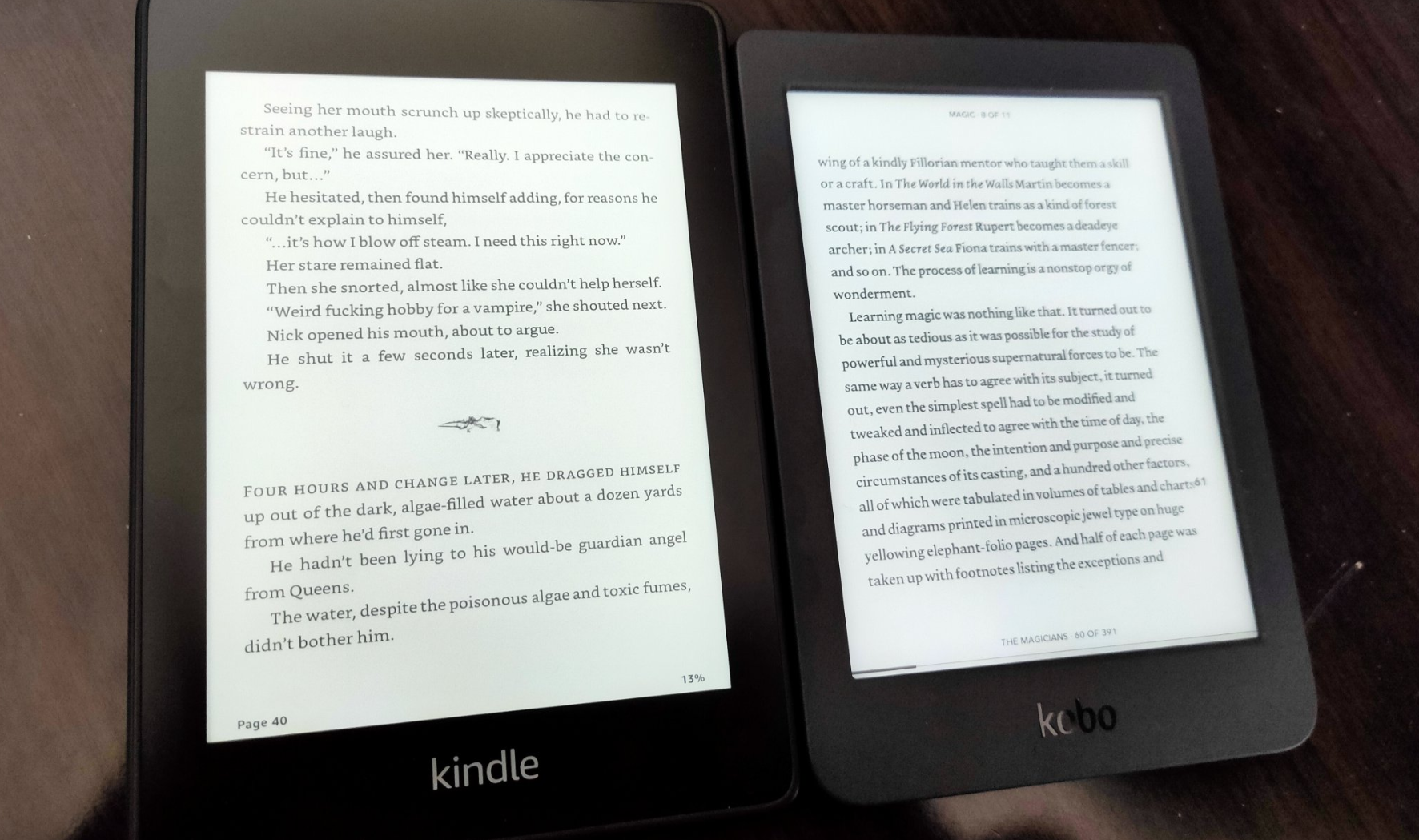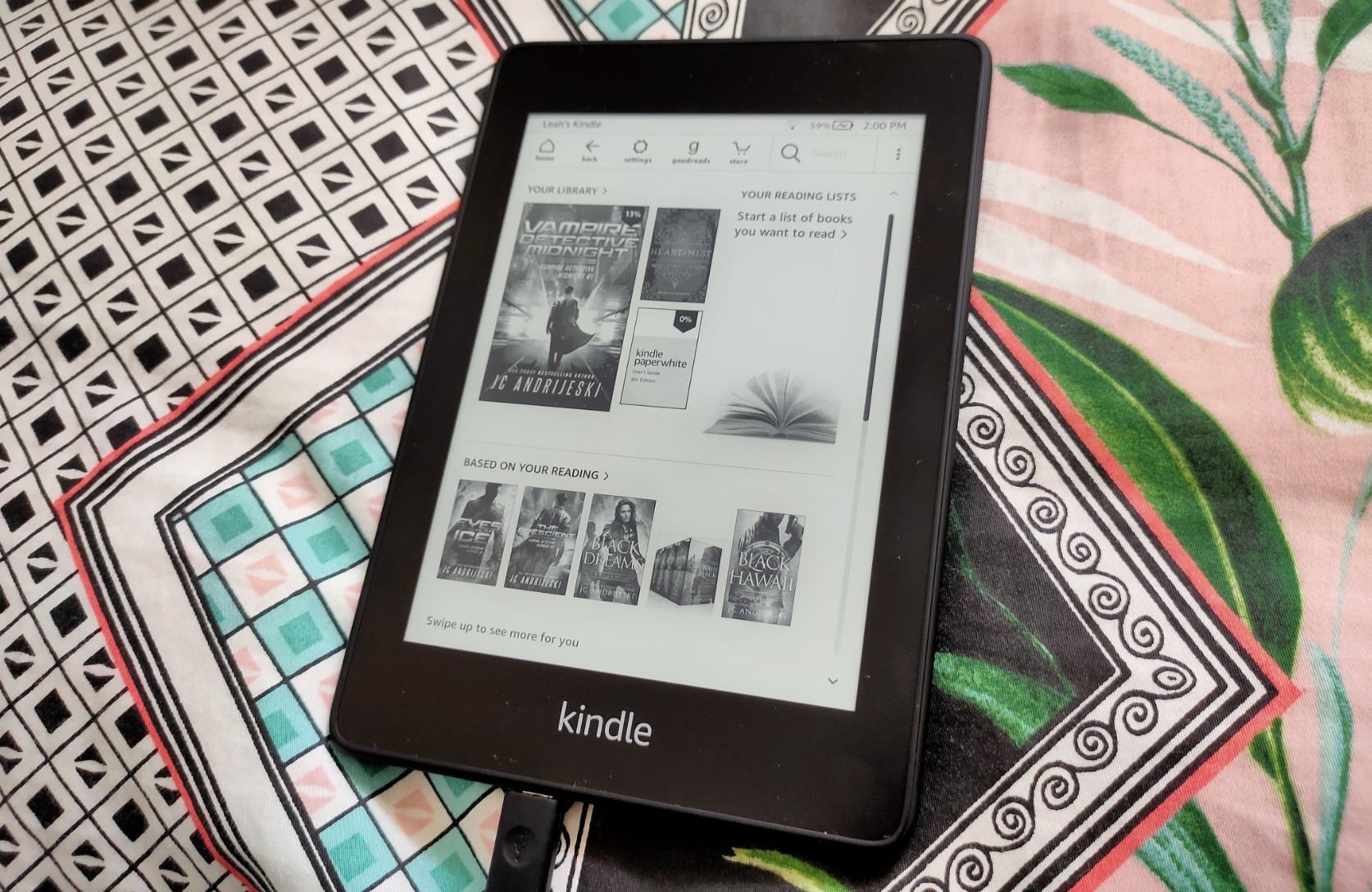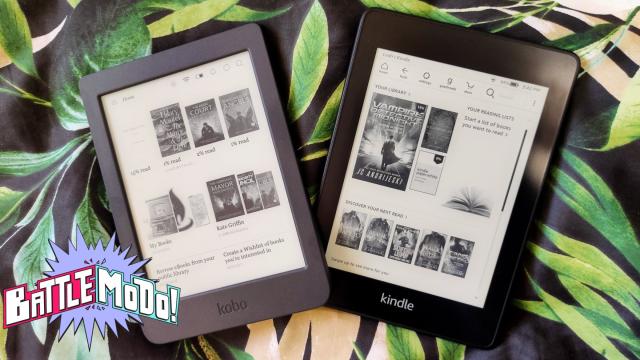The Kindle Paperwhite is a great e-reading device. It boasts a fast processor, a sleek look, and an array of useful features designed to create a pleasant reading experience whether you’re taking your e-reader to the bath, beach or bed. While it currently dominates the mainstream e-reader market, there’s a new up-and-comer heading for its crown: the Kobo Nia. The Nia is priced $50 cheaper than the Paperwhite and boasts an array of features that threaten to dethrone the dominant e-reader king.
Read on as Gizmodo Australia pits these two competitors against each other.
Kindle Paperwhite: Specs & Features
- Display: 6-inch glare-free, 300 ppi E Ink display
- Battery: 1,500 mAh
- Storage: 8GB or 32GB
- Features: waterproofing, text-to-speech, bluetooth
- Price: starts at $199
Kobo Nia: Specs & Features
- Display: 6-inch glare-free, 212 ppi E Ink display
- Battery: 1,000mAh
- Storage: 8GB
- Features: native Overdrive support, full file compatibility
- Price: starts at $149.95
Both the Kindle Paperwhite and Kobo Nia are 6-inch e-readers designed for mainstream audiences. At $199 and $149.95 respectively, they’re extremely reasonably priced and highly competitive in the e-reader market. Here’s how they compare.
Display

While both the Kobo Nia and Kindle Paperwhite are 6-inch devices designed to fit into the palm of your hand, the Paperwhite is slightly longer than the Nia and can be a little more difficult to navigate because of this. Regardless, both devices have clean, easy-to-use displays and feature similar touch-based functionality.
The Paperwhite has a crisp 300 ppi display, while the Nia’s stands at 212 ppi. This makes text on the Paperwhite noticeably smoother and thinner than the the text on the Nia.
The Paperwhite’s screen is also backed by a marginally faster processor and loads pages around 0.5 seconds faster than the Nia — but neither factor will impact your enjoyment of the latter unless you’re directly comparing the two. Both e-readers have nice-looking displays and are very responsive to touch controls.
Overall design is a minor concern in the grand scene of things, but the Paperwhite does have a leg up over the Nia here. The Paperwhite has a slick rubberised casing that’s pleasant to hold and easy to grip. Comparatively the Nia has a rough plastic exterior and textured back that cheapens the feel of the device.
Still, they’re both very sleek, attractive e-readers and perform well during everyday tasks. Little touches give the Paperwhite the edge here, though.
WINNER: Kindle Paperwhite
Battery Life
Both the Kindle Paperwhite and Kobo Nia should last you around 4 to 6 weeks in active use (around 1 hour per day) depending on how long you read use your e-reader for daily. While the Paperwhite has a 1,500mAh battery and the Nia has a 1,000mAh battery, both share very similar longevity.
After a week of hourly-per-day use, the Kindle dropped to 83 per cent power on mid-range brightness. In similar circumstances, the Nia reached 79 per cent battery power. It means both devices will give you a whopping amount of time before needing a charge.
Each device featured a similar amount of battery degradation per use, with neither coming out on top — but there was another deciding factor here.
The most notable difference here was in charging the devices back up to full power. From a 50 per cent battery charge, it took the Paperwhite about an hour to reach 100 per cent. It means a full charge will take around two hours depending on which charger you use.
The Kobo Nia was good for a 50 per cent top-up in just 30 minutes, making its charging time closer to an hour. It’s a strange quirk, and a notable loss for the Paperwhite.
WINNER: Kobo Nia
User Interface
While both feature similar user interfaces, the Nia’s homepage wins out here, mostly because it’s simpler than the Paperwhite’s cluttered homepage and focuses on owned books rather than suggestions based on what’s popular online.
The Paperwhite is more inclined to sell you new books from the Kindle Store, rather than focus on what you’ve already got. It’s also got several busy menu columns on the home screen that make it difficult to see which books you actually own.

In comparison, the Nia’s menu system is very neat and prioritises your owned e-books by sorting them into categories including books you’re currently reading. At the bottom, there’s also easy access to Overdrive, the app letting you borrow books from your local library.
If you want to access the Kobo store from the main menu, you just need to hit the options button and load in — but the device will never sell you books unless you choose to visit the store. For general user experience and a more pleasant interface, the Kobo wins out here.
WINNER: Kobo Nia
Features and Compatibility
Two major features set the Paperwhite and Nia apart: file compatibility and waterproofing.
The Kindle Paperwhite is compatible with .mobi, .azw, .prc, .txt and .pdf files. For anything outside this, including standard .epub formats, you’ll need to download a third-party application called Calibre, which lets you convert your files. The Kobo Nia, on the other, accepts the majority of document formats including .pdf, .mobi, .epub, .txt, .jpeg, .cbz, .cbr and more. If you’re dealing with more exotic file types, the Nia can handle pretty much everything — unless it’s a sound file.
Unlike the Nia, the Kindle Paperwhite can technically handle audiobooks via bluetooth audio devices. This does come with a major caveat — the service doesn’t appear to work in Australia. There are some workarounds, like setting up a U.S. Audible account and formatting the Kindle as such, but it’s a complicated process worth keeping clear of.
[related_content first=”1233458″]
Instead, the Paperwhite offers a VoiceView Screen Reader service where users can connec a bluetooth speaker and have ebooks read out to them. The VoiceView voice is actually quite pleasant and doesn’t sound too robotic, making it a perfectly viable way to turn any book into an ebook if that’s more your speed. It’s also a great accessibility feature for vision-impaired readers. Unfortunately, the Nia doesn’t offer an equivalent service.
The other major difference here is that the Paperwhite is waterproof, while the Kobo Nia is not. It means you can safely use the Paperwhite in the bath or around any body of water without fear of breaking it. Visiting the beach? No dramas. Swimming by the lake? Sure. Dropping it in the toilet? Gross, but yes, you can. The Nia is not waterproof, meaning using it in these places is a bit more dangerous.
That said, if you’re careful with your things, the lack of waterproofing won’t be a major drama — just something to keep in mind. While file compatibility and menu design are important considerations, an extra $50 for some peace-of-mind in case of an accident goes a long way, too.
WINNER: Kindle Paperwhite
Which should you buy?

The Kindle Paperwhite is a hardy e-reader companion for those who like reading in the strangest of places. The major caveats with the device are its limited file compatibility, cluttered menu system and lack of audiobook support but none are dealbreakers for the device. When put to task, the Paperwhite will deliver — whether you’re in the bath, by the ocean or just relaxing in bed.
The Kobo Nia boasts many of the features the Paperwhite lacks including file compatibility with nearly every document type and a neat library-focused menu system that won’t try to sell you your next read. It’s also $50 cheaper — but this price does come with a caveat.
Unlike the Kindle Paperwhite, the Nia doesn’t support audio features like text-to-speech or ebooks. As mentioned, it’s also not waterproof. While you will technically be able to use the Nia in the bath, it doesn’t guarantee continued functionality if you drop it.
If you’ve ever had an water-based accident with a device (and most of us have), the safety of the Kindle Paperwhite is definitely worth the added cost.
That said, the Nia does provide the best overall experience for readers and is far less annoying than the Paperwhite, which provides constant Kindle Store ads. If you’re looking for a more pleasant, minimalist option and you’re less accident-prone than the average joe, the Nia is for you.
Whether you choose the Kindle Paperwhite or the Kobo Nia, there’s plenty to love about both gadgets. The major deciding factor here will be your waterproofing requirements and whether or not you depend on third party file sources for your ebooks. The $50 price difference here is arbitrary in the long run, with both devices sharing similar specs, speed and overall functionality.
In short: they’re both great e-reader devices so you should consider your personal preferences before you head out to purchase either e-reader.
